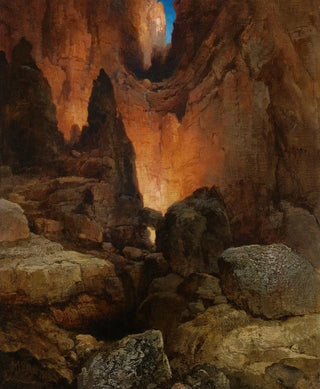Art print | A lateral canyon of the Grand Canyon of Arizona - Thomas Moran


View from behind

Frame (optional)
In the vastness of American landscapes, the Grand Canyon stands as a natural monument, a masterpiece carved by time and the elements. The art print "Un canyon latéral du Grand Canyon de l'Arizona" by Thomas Moran captures this majesty with rare intensity. Through his brushstrokes, Moran manages to convey the grandeur and serenity of this iconic place, inviting the viewer to a full immersion in the wild beauty of nature. This art print of the work allows for rediscovering not only the landscape it depicts but also the emotion evoked by contemplating this grand panorama.
Style and uniqueness of the work
Thomas Moran's work is distinguished by his masterful use of color and light. In "Un canyon latéral du Grand Canyon de l'Arizona," the warm hues of the sunset blend with the shadows of the cliffs, creating a striking contrast that brings the canvas to life. Moran, a true alchemist, plays with nuances to evoke an atmosphere that is both peaceful and majestic. The composition of the work, where the lines of the rocks are drawn with precision, guides the viewer's gaze through the canyon, like an initiatory journey into the heart of the wild. This ability to capture the very essence of the landscape makes Moran a pioneer of the American landscape movement, and his unique style continues to inspire contemporary artists.
The artist and his influence
Thomas Moran, born in 1837, is often regarded as one of the pioneers of landscape painting in the United States. His passion for nature and his desire to depict it faithfully led him to explore the country's most beautiful natural sites. Moran played a key role in promoting the beauty of American landscapes, notably through his works that helped establish Yellowstone National Park. His technique, marked by early Impressionism, was able to capture not only the visual but also the emotion that these landscapes evoke. By integrating elements of light and color, he created a new way of seeing nature, influencing many artists of his time and future generations. Today, his work remains an essential reference for

Matte finish

View from behind

Frame (optional)
In the vastness of American landscapes, the Grand Canyon stands as a natural monument, a masterpiece carved by time and the elements. The art print "Un canyon latéral du Grand Canyon de l'Arizona" by Thomas Moran captures this majesty with rare intensity. Through his brushstrokes, Moran manages to convey the grandeur and serenity of this iconic place, inviting the viewer to a full immersion in the wild beauty of nature. This art print of the work allows for rediscovering not only the landscape it depicts but also the emotion evoked by contemplating this grand panorama.
Style and uniqueness of the work
Thomas Moran's work is distinguished by his masterful use of color and light. In "Un canyon latéral du Grand Canyon de l'Arizona," the warm hues of the sunset blend with the shadows of the cliffs, creating a striking contrast that brings the canvas to life. Moran, a true alchemist, plays with nuances to evoke an atmosphere that is both peaceful and majestic. The composition of the work, where the lines of the rocks are drawn with precision, guides the viewer's gaze through the canyon, like an initiatory journey into the heart of the wild. This ability to capture the very essence of the landscape makes Moran a pioneer of the American landscape movement, and his unique style continues to inspire contemporary artists.
The artist and his influence
Thomas Moran, born in 1837, is often regarded as one of the pioneers of landscape painting in the United States. His passion for nature and his desire to depict it faithfully led him to explore the country's most beautiful natural sites. Moran played a key role in promoting the beauty of American landscapes, notably through his works that helped establish Yellowstone National Park. His technique, marked by early Impressionism, was able to capture not only the visual but also the emotion that these landscapes evoke. By integrating elements of light and color, he created a new way of seeing nature, influencing many artists of his time and future generations. Today, his work remains an essential reference for






